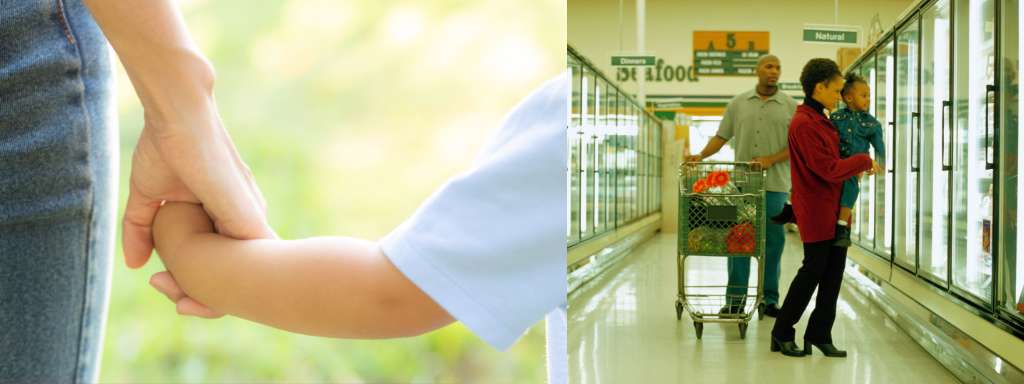Ever been in a supermarket and witnessed a toddler having a tantrum? We thought so. Chances are you thought nothing of it and got on with your shopping (after maybe giving the adult with them a sympathetic glance).
Of course, it feels different when it’s your own child! But rest assured; everyone nearby will no doubt have experienced exactly the same thing before at some point – either as a parent, a sibling, a grandparent, a bystander, friend, or (dare we say it) as an actual toddler themselves.
Looking for fun activities with your baby or toddler?
There are thousands of classes and groups on Happity. Find one you’ll love here.
1. Make It Manageable

So, why does my toddler act out in stores? Supermarkets can be overwhelming, right? Even for adults, all those aisles, products and choices to be made; not to mention the noise of other shoppers, visual overload from signs and offers, smells from the bakery. It’s no wonder that some toddlers will go into meltdown.
Then there’s the temptation to rush around as quickly as possible if you’ve got a toddler on board. Instead, try slowing down and talking to your toddler as you go round so they know what to expect in each section. “First we’re going to the fruit and veg. Let’s choose three bananas! They look yummy, don’t they? We’ll go to the bakery now. You might be able to smell the bread.”
2. Keep It Short

If you have a list of five things to buy, try to stick to the five things. You may find you need to go shopping several times a week if you have a toddler in tow. Build up gradually from five or ten minutes in the shop to longer trips if your toddler can handle it.
3. Let Them Help

Even the youngest toddler will enjoy being involved. Maybe they can hold a piece of fruit and veg, hold (and tick off) the shopping list, weigh the produce or help load and pack at the checkout. If it’s a supermarket with a handheld scanner, you might find your toddler can press and hold the button. Feeling they are actively taking part in something rather than passively watching is all some toddlers need to stave off the boredom. How about a small shopping bag to carry or a mini-trolley for them to push?
4. Give Choices, But Don’t Give Into Demands

Maybe they could help choose which type of apples you buy today, or whether you pick red or green grapes.
It’s likely with all that yummy food on show that your toddler will want this or that. Within reason, you may be able to redirect this to a choice or alternative. “We can’t buy chocolate today, but can you help me choose which ice cream?” Or, “Chocolate biscuits aren’t on the list, so let’s find another snack you like”. Of course, for some toddlers, this still may lead to a tantrum. For others, it may do the trick.
5. Pre-empt Hunger

When we’re hungry, we don’t function well and neither do our children. By giving your child a small snack or piece of fruit just before you go shopping, or even as they’re sitting in the trolley, you can help pre-empt one of the most common reasons for toddler tears. Some supermarkets have baskets of free fruit near the entrance for your toddler to help themselves!
6. Stay Calm Amidst The Toddler Tantrum

If your toddler starts having a tantrum right there, in the middle of the supermarket, remember this is normal behaviour, and your main job is to stay calm yourself. Parenting expert Janet Lansbury recommends that you imagine yourself donning an invisible Superhero cloak and thinking “I’ve got this. Remember the tantrum is a call out for your help. Your child literally can’t cope in the moment, and you’re there to safely guide them through the other side.”
7. Have A Safe Space

If your toddler has a tantrum, you may need to pick them up, or take them by the hand, and lead them to a safe space – by safe we also mean a place where they can be with you and feel safe to let out their emotions (as well as avoiding all those glass bottles on the ketchup aisle). This could be a quieter space in the shop such as the entrance hall, a green space outside, or even your car. Think of it as ‘my child needs to release these emotions and they need to do it now’. As a parent or carer, you probably prefer not to have a big audience, either!
Chances are that once they’ve calmed down, you will be able to go back into the shop and continue shopping.
Sometimes a tantrum may be mild enough for them to stay in the shop and for you to talk to them quietly (crouch down at their level). Or it could be the other extreme and they’re safer staying in the shop away from the car park. You’ll just have to ride this one out. But remember, you’ve got this!
8. Steady The Buffs – Is it OK to hold my toddler during a tantrum?

Is it OK to hold my toddler during a tantrum? Of course it is! Some children may need or want to be held during the tantrum to make them feel safe – or keep them safe, if they’re flailing out near the corner of a shelf for example.
Others hate being held – particularly when they’re upset. And it can also be difficult to hold a child who is wriggling. Rather than a hug (which can feel overwhelming), stay close by and just be ready to catch their wrist or arm if they hit out and you need to intervene to keep them, or other people, safe.
Remember you’re the expert on your own child (even if it doesn’t feel like it in the moment) so go with your instincts. If your child is safe, you can safely observe from a slight distance until your child begins to calm down and wants your attention.
9. Be Prepared To Veto The Shopping For A While

If you’ve tried everything and your toddler is still having long tantrums, perhaps it’s time to rethink the food shop. Could you go online? Do a click-and-collect? Shop when they’re at nursery? Switch with your partner so one of you stays home and the other does the shopping? Sometimes a child simply isn’t at a point where you can avoid a tantrum in a supermarket. They’re just not ready to be in that environment. Even a month or two can work wonders for a child’s growth and development.
10. Remember It’s Not Forever

It’s another stage and your child will come out the other side. So at what age do toddler tantrums peak?
Most experts say between 18 and 36 months. But every child is different: you may be lucky and find that with extra planning, you can nip most tantrums in the bud. By around age 4, you should be out of the woods. But, of course if you want extra reassurance, you can always have a quick chat with your GP. And remember it’s completely normal for life changes, like a new school or a new school year, to lead to tantrums in older children too. If your child does keep having tantrums for a bit longer, try to stay positive. Soon you’ll be such an expert in tantrums that they won’t phase you at all!
Want To Get Out And About, Have Fun With Your Baby Or Toddler, And Meet Other Parents?
Search Happity to find everything that’s happening for the under-5’s in your local area – from music and singing classes, to messy play, arts and crafts, baby massage, gymnastics and more. Simply enter your postcode and child’s age to search, and then book your spot in a few taps. Enjoy dedicated fun time with your little one, watch their skills develop, and make friends at the same time. Mums, dads, grandparents and carers will all find something to love!
If You Found This Post Useful, You May Also Like:
10 Healthy (and Cheap) Snacks To Prep For Picky Toddlers
How To Get Started With Potty Training
11 Easy Tips For Getting Your Children Involved In the Kitchen



0 Comments